Contentious Discovery Dispute Process Leads to Ruling on “Reasonably Usable Format” for ESI – eDiscovery Case Law

In Castillon v. Corrections Corporation of America, Inc., No. 1:12-cv-00559-EJL (D. Idaho Feb. 7, 2014), Idaho District Judge Edward J. Lodge found a discovery dispute over the form of production of electronically stored information (ESI) in favor of the defendants, who had already produced the requested data in what was ruled a “reasonably usable format.”
This civil rights action displayed a demonstrated lack of cooperation between opposing counsel from the outset of the discovery phase. Following the first discovery disputes, it was noted that counsel had “refused to interact with each other reasonably and civilly. Many of the motions and briefs filed by both parties are full of hyperbole and contain unfounded accusations against opposing counsel.” While a discovery mediation had been somewhat successful in that both parties resolved many of the issues and filed a Stipulation as to certain discovery disputes, contention returned after just over one month, when the plaintiffs filed a Motion to Compel regarding information that was allegedly covered in the production produced by the defendants thus far.
Specifically, the plaintiffs sought to compel “all documents and communications including copies of the unit log books, shift logs, and other activity logs for all staff and contractors” employed by the defendants, as well as “all documents and communications including all records containing the terms of compensation and bonuses for any CCA employee with any supervisory authority” within a stipulated time period of January 1, 2009, to December 31, 2012. This discovery was categorized under Requests for Production Nos. 10 and 12, respectively.
The plaintiffs claimed that the information provided by the defendants regarding compensation and bonuses contained data for only one of the three named employees in supervisory capacities that they had requested, and further that the time frame of the information provided was insufficient. Additionally, the plaintiffs took issue with the format in which the documents were provided—specifically, searchable PDFs. The plaintiffs argued that “this is not a reasonably usable format and request that this information be re-produced in machine readable format and also request data covering a longer period of time.”
With regard to the first point of information concerning three specific supervisory employees, Judge Lodge ruled that the two employees for which data was not provided were outside the scope of discovery for this case. Specifically: “They do not work at ICC. They are not prison wardens. Therefore, Plaintiffs’ Motion to Compel improperly seeks information that Plaintiffs did not include in their discovery request. Plaintiffs’ Motion is therefore frivolous.”
Regarding the form of production for the documentation requested, the defendants pointed out that they had produced the data from their timekeeping database in searchable PDF format, which is the format that their system natively exports data. The defendants outlined the scenario that would allow them to produce ESI in the .csv (comma separated values) format requested by the plaintiffs as unduly burdensome and duplicative, as it would “require CCA to write a script that would then enable [the system] to export the time detail information Plaintiffs seek,” a process that would be “lengthy and daunting” and require “a team of between three and four people […] to expend three to four days creating the script, testing it, and confirming the accuracy of the data it produces.”
Judge Lodge ruled that because the defendants had already produced the requested data, they would not be required to produce it again in a different form. Further, it was noted that searchable PDF format is considered a reasonably usable form because “as the name implies, it can be easily searched.” The plaintiffs’ Motion to Compel was denied, though it was stipulated that if the plaintiffs agreed in writing to pay the defendants’ expenses in creating the script required to produce data in the requested format, they could approach the defendants with such a request.
So, what do you think? Should the term “reasonably usable form” cover any searchable format of ESI? Which party should be responsible for the costs of producing ESI in a specified format agreed on during discovery? Please share any comments you might have or if you’d like to know more about a particular topic.
Disclaimer: The views represented herein are exclusively the views of the author, and do not necessarily represent the views held by CloudNine Discovery. eDiscoveryDaily is made available by CloudNine Discovery solely for educational purposes to provide general information about general eDiscovery principles and not to provide specific legal advice applicable to any particular circumstance. eDiscoveryDaily should not be used as a substitute for competent legal advice from a lawyer you have retained and who has agreed to represent you.







